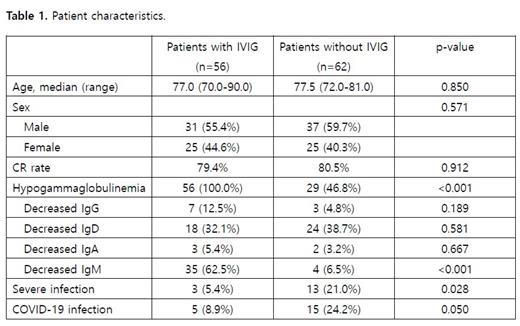Background
The median age at initial diagnosis of DLBCL is estimated to be between the ages of 60 and 70. The number of elderly patients with DLBCL is gradually increasing. But, treatment outcomes of elderly patients were not significantly improved compared to younger patients. Infection is an independent predictor of treatment outcome in patients with DLBCL, and the risk of infection increases with age. The incidence of hypogammaglobulinemia in patients with malignant lymphoma increased from 15% to 39% after rituximab therapy. There was a significant decrease in the occurrence of major infections after intravenous immunoglobulins (IVIG) prophylaxis in hypogammaglobulinemia patients with lymphoproliferative. disorders. In this multicenter prospective study, infection prevention effect and treatment outcomes were identified using IVIG in elderly DLBCL patients with hypogammaglobulinemia who received rituximab combination chemotherapy.
Methods
In the current study, newly diagnosed DLBCL patients aged 70 years or older who were planning to receive R-mini-CHOP therapy were included. Patients with hypogammaglobulinemia at diagnosis were assigned to the IVIG group. Patients received R-mini-CHOP (rituximab: 375mg/m 2 D1; cyclophosphamide: 400mg/m 2 D1; doxorubicin: 25mg/m 2 D1; vincristine: 1.0mg D1, and prednisolone 40mg/m 2 from D1 to D5), and pegylated G-CSF. After the first cycle of R-mini-CHOP, 400mg/kg of IVIG was administered on D3 and D11. After the second cycle to sixth cycle of chemotherapy, patients received 400mg/kg of IVIG on D11. The primary objective was to evaluate the efficacy of IVIG in reducing severe infections. Grade 3 or 4 infections were defined as severe infections.
Results
A total of 118 elderly patients were newly diagnosed with DLBCL and were scheduled to receive R-mini-CHOP therapy. Hypogammaglobulinemia was identified in 85 (72.0%) patients. Decreased immunoglobulin D (n=42) and immunoglobulin M (n=39) level were most common, and 18 patients had two or more types of hypogammaglobulinemia at the same time. Fifty-six patients were assigned to the group receiving IVIG. Median age was 77 years (range, 70-90), and 31 (55.4%) were male. In patients who completed R-mini-CHOP and IVIG treatment, complete remission rate was 79.4%. Severe infections of grade 3 or 4 occurred in 3 of 56 (5.4%) patients, and only five (8.9%) patients had COVID-19 infection during the study period. Adverse effects associated with IVIG include fever/chilling, nausea/vomiting which were generally manageable. Only one patient discontinued the study because of chest pain that occurred during IVIG administration. In patients with hypogammaglobulinemia who did not receive IVIG, severe infections occurred in 8 of 29 (27.6%) patients, and COVID-19 infection was developed in 7 of 29 (24.1%). In patients without hypogammaglobulinemia, severe infection occurred in 5 of 33 (15.2%), and COVID-19 infection was developed in 8 of 33 (24.2%) patients. Patients receiving IVIG had a significantly reduced incidence of severe infection compared to patients not receiving IVIG (p=0.028). Furthermore, COVID-19 infection rate during R-mini-CHOP therapy was lower in IVIG receiving patients (p=0.050). Long-term outcomes with relapse rate and survival will be followed up and updated.
Conclusion
In elderly patients with DLBCL, the combination of R-mini-CHOP and IVIG was safe and effective in preventing infection. In the COVID-19 era, the combination of chemotherapy and IVIG should be considered in elderly DLBCL patients to reduce infection rate and improve treatment outcomes.
Disclosures
Lee:Takeda: Honoraria; Janssen: Consultancy; Takeda: Consultancy; Janssen: Honoraria.


This feature is available to Subscribers Only
Sign In or Create an Account Close Modal